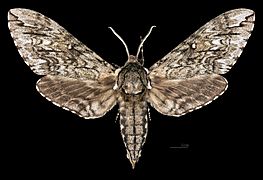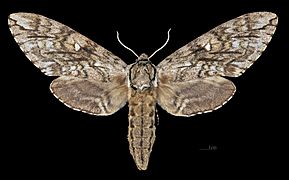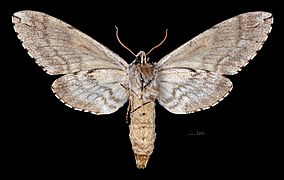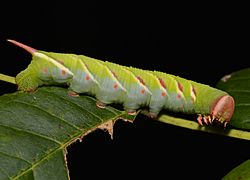Waved sphinx facts for kids
Ceratomia undulosa, also known as the waved sphinx, is a type of moth. It belongs to the Sphingidae family, which are often called "sphinx moths" or "hawk moths." This moth was first described in 1856 by Francis Walker. Sometimes, people mistakenly call it the "Scorpion Moth."
Quick facts for kids Waved sphinx |
|
|---|---|
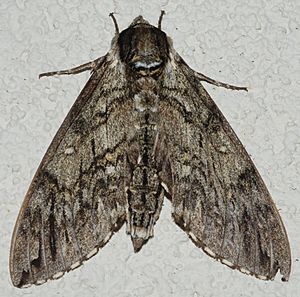 |
|
| Adult specimen | |
| Scientific classification | |
| Synonyms | |
|
Contents
Where the Waved Sphinx Lives
You can find the waved sphinx moth in the United States and southern Canada. They live mainly to the east of the Rocky Mountains. These moths are nocturnal, meaning they are active at night. When dawn comes, they hide away until it's dark again.
What the Waved Sphinx Looks Like
The waved sphinx moth gets its name from the wavy patterns on its wings. Both male and female moths have these patterns. Young waved sphinx moths are called caterpillars. They look very different from the adult moths.
Life Cycle and Habits
What Caterpillars Eat
The caterpillars of the waved sphinx moth like to eat leaves from certain trees. They have been seen eating from ash trees (Fraxinus species). They might also eat from oak trees (Quercus species).
From Caterpillar to Moth
After the caterpillars have eaten enough, they are ready for the next stage. They dig into the ground to become a pupa. This is a resting stage where they change into an adult moth.
Why It's Called "Scorpion Moth"
Sometimes, people call the waved sphinx the "Scorpion Moth." This is because a type of scorpion, the Guiana Striped Scorpion, is often found near the moth's eggs. The scorpions sometimes eat the moth's egg clusters. Because they are often seen together, some people used to think the moths somehow gave birth to scorpions. This idea is not true, but it led to the nickname "Scorpion Moth."
Types of Waved Sphinx Moths
There are a few different types, or subspecies, of the waved sphinx moth.
- Ceratomia undulosa undulosa: This type is found across a wide area. It lives from Prince Edward Island and Nova Scotia in Canada, west to eastern Alberta. In the United States, it ranges from Maine to Florida and west to the eastern Great Plains.
- Ceratomia undulosa polingi: This type was described in 1929. It is found in Mexico.


